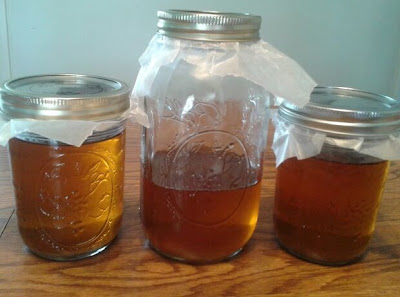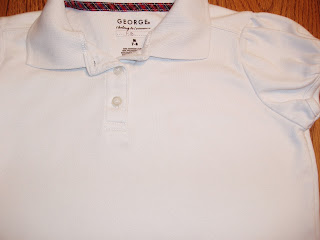If you haven't read
You Can Make Maple Syrup (Seriously...It's Easy!) then you might want to do that first, because today we're covering how to boil the sap down to syrup (part 2).
As a little recap, first you find and identify your maple tree(s). Here's a link to a
UofM article to help identify maples for making syrup. And
another resource I found shows a few silhouettes of different trees with additional links, and
one more simple resource has good pictures of the bark and twigs of sugar maples. Hopefully, this helps to identify your trees (it is tougher to figure it out in winter).
 |
| Maple seed pods |
 |
| Distinctive maple leaf shape |
You'll have to try to remember from last fall, but their leaves are very distinctive looking. Typically, they are the first ones to turn colors in the fall and can be brilliant shades of orange and red (our tree just turns yellow). They are also the ones that produce those little "helicopter" or "whirlybird" seed pods in the spring/summer.
 |
| Looking down into collection bucket |
 |
| Maple sap looks like water |
Also, be aware, the sap has the same look and consistency of water. And there is barely any sweet flavor to it at all; that's because at this point it is only about 1-3% sugar. Finished syrup has 66% sugar.
After your collection buckets get full, pour them into a larger storage bucket (we used a 5 gallon plastic bucket). You can filter it at this time through a fine mesh strainer before pouring into the storage bucket to remove any large pieces of sediment, bark, bugs, etc. Then you'll need to keep the storage bucket in a cool place until you decide to boil. We took shelves out of our second refrigerator and kept it in there, but I've read where you can even pack your container in snow to keep it cool, out of the way of the sun.
Properly stored sap will keep up to one week, but then you must boil it down, as it can spoil if kept any longer. We were able to fill 2 five-gallon buckets ranging between 2-5 days, but we collect from two trees (our super huge tree and our neighbor's tree). The amount you collect will vary; just plan on boiling it down within a week.
So Let's Do It!
You need to decide the best place to boil the sap down. And it needs to be a place with good ventilation, because it will produce a tremendous amount of moisture in the air. Here are some ideas: Outdoor fireplace, outdoor fire pit with a grate to set your pot on, an outdoor turkey fryer would work great, an outdoor grill, etc.
 |
| Boiling 3 pots to speed the process |
Since my husband is an appliance guy, we plugged in an old stove out in his shop and left the doors open. At one point we forgot to keep the doors open and when we went in to check on it, the humidity was at 70%!
So make sure you have an accurate candy thermometer and start boiling away! I read one tip to help keep it from boiling over is to rub butter around the rim of the pot. Then just keep (carefully) adding your sap to the boiling pot. On our second batch, we decided to run 3 pots at once to speed it up and then added them to one main pot.
As it boils down to a smaller amount, you can transfer the liquid to a smaller pot and bring it in the house to finish it off (you still might want to leave a window open for a little ventilation).
The rule of thumb is to boil it until it reaches 7 degrees hotter than when it first boiled (boiling point is apparently affected by your altitude, so take note of the temperature it first boils and add 7 degrees). Here in Wisconsin, water boils at 212 degrees Farenheit, so it will be done when it reaches 219 degrees Farenheit. And as the temperature starts to rise above 212, you'll need to watch it very closely, because it will get to 219 rather quickly.
To Filter, Or Not To Filter?
There are 3 options when it comes to filtering (in a simple home setting):
- Filter when it is hot
- Decant (pouring it off after it settles 24 hours)
- Don't filter
Hot Filter. What you are filtering is what is called "niter" or sugar sand. It is a harmless substance made of various minerals and won't hurt you if you consume it, but it doesn't look pretty. So if you want to filter it, you must do it when it's hot, because once it cools it'll be way too thick! And even though you may have filtered before you boiled, the niter is extremely fine and you'll need to filter through a very fine substance like flour sack cloth, wool, a few layers of cheesecloth or a special orlon material made for filtering syrup. You'll want to "prime" or pre-moisten your filter by getting a small amount on it and gently squeezing, otherwise it may just pool and spill over the edge.
Decant. If you go with the decant method then you don't need to worry about filtering at this point. You'll just pour the syrup in the jars and let it sit 24 hours. The niter will settle to the bottom and then you can pour it off into another container, leaving the niter behind in the first container.
Don't Filter. As I mentioned above, the niter is harmless, it just doesn't look nice. The choice is up to you.
Syrup Storage
 |
| Decanted, finished syrup |
What's nice about maple syrup is that you don't have to "can" it in the traditional sense of the word, because the high sugar content in the syrup (66%) helps to self-preserve it. You can further enhance the preservation of your syrup by keeping it in the refrigerator or freezer (although it's not absolutely necessary). Take note that the high sugar content will prevent it from freezing solid.
So all you really
have to do is make sure you are putting it in clean, dry, food-safe containers, like we did for our first batch pictured at right.
Another option is to seal the syrup in canning jars. However, you'll need to work quickly, pouring it as soon as possible after you hot filter it, so the temperature doesn't drop too much. Then you'll need
to pop the lids on and gently tip the jars on their side, so the lids stay as hot as possible to help them seal right.
Another variation of this is to first do the decant method. Then after 24 hours pour (decant) the syrup into a saucepan and heat to 180 degrees, then pour it into canning jars and tilt them on their sides to help them seal.
Are You Going To Try It?
As I'm writing this, we're boiling down our
3rd batch of sap! We got 2 five gallon buckets filled
again in just 2 days...it's crazy! The sap is still running strong...so it's not too late...I'm telling you, you can start today and have syrup by this weekend!
So how about it? Is there anyone out there willing to try? Talk to me in the comments below...or ask me any questions...or post your own pictures on
Facebook.
In a couple days I'll conclude this little "series" on maple syrup, comparing its nutritional aspects to regular pancake syrup, and talk about closing up the syruping season. High quality food is as important to me as high quality natural skincare products. And with SkinKissed Naturals products you get
beautiful skin, that
feels good, that you will
feel good about.
Click this link to take a peek at SkinKissed Naturals natural skincare products.













.jpg)











